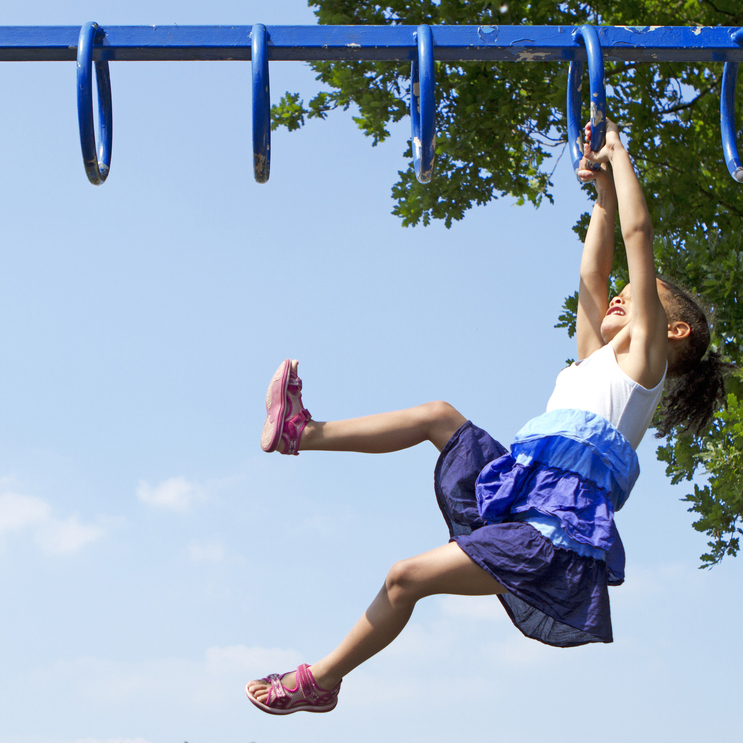
What is the best way to keep young kids physically active at home? In good news for parents with limited outside space, new Australian research shows that it’s not necessarily the size of your backyard that matters. Rather, it’s fixed equipment – things like cubby houses, trampolines or even something as simple as a sandpit – that makes all the difference.
The study in the latest issue of Public Health Research & Practice, published by the Sax Institute, looked at home-based outdoor play in nearly 1600 preschool children on days when they were not in childcare. Researchers from The University of Western Australia clocked the time the children spent playing outdoors against a number of factors, including backyard size, outdoor features (grassed or paved areas, trees, gardens), fixed play equipment (climbing structures, playhouses, sandboxes, swings, trampolines) and portable play items (balls, frisbees, scooters, etc.).
When not in childcare, children spent a little over an hour a day playing in their backyard. But the only factor clearly associated with increased playtime outside was the number of fixed play structures in the backyard. Each additional piece of equipment added an average of 5 minutes to a child’s daily playtime, the researchers found.
“This is the first time we’ve been able to comprehensively measure outdoor playtime in the home environment,” says the study’s senior author Associate Professor Hayley Christian, who is a Senior Research Fellow at The University of Western Australia’s School of Population and Global Health and Telethon Kids Institute.
“The home yard space is crucial for providing opportunity for preschool kids to be active, as they are so dependent on their parents and don’t have the independent mobility to get out and about on their own. We’ve found that within the yard space, having play equipment can make a big difference to the amount of activity they do each day.”
The Australian government recommends that preschoolers spend at least three hours a day being physically active, but this is only achieved by around a third of children, the study authors note. One in five Australian preschoolers are now considered overweight or obese.
“Backyard play is a much better option than screen time, considering all of the health and developmental benefits children get by playing outdoors and being physically active” Dr Christian says.
“As parents we may not have time to take our kids to the park each day, but they don’t need to be in the house on a device. Why not allow them out in the yard and let them go!”
The researchers say their findings also have implications for policy around high-density housing, where homes may have limited or no outside private space. The inclusion of accessible preschooler-friendly space and equipment for play as part of all new high-density developments is an important consideration.
The research on preschoolers’ outdoor play is one of a number of papers dealing with childhood health and obesity in a special themed issue of Public Health Research & Practice, overseen by Co-Guest Editors Dr Jo Mitchell, Executive Director of the Centre for Population Health at the NSW Ministry of Health, and Professor Louise Baur AM, Head of Child and Adolescent Health at the Sydney Medical School, University of Sydney.
Other papers in this issue include two which take differing views on the Health Star Rating System – the voluntary front-of-pack information panels that attempt to summarise the nutritional value of packaged foods. One of these articles, led by Professor Mark Lawrence of the Faculty of Health at Deakin University, argues that the system misrepresents nutrition science, contradicts Australian Dietary Guidelines and promotes foods that are high in fat, salt and sugar.
The other paper takes a different view, arguing that Australians are changing their long-term behaviour and making healthier choices at the supermarket, thanks to the Health Star Rating system.
Other articles in this issue of Public Health Research & Practice find:
- Providing children with fixed outdoor play equipment is the best way to increase kids’ activity levels, with each additional piece of fixed equipment adding five minutes to total daily playtimes.
- Health services should use growth assessments to routinely identify and manage children who are above healthy weight – just as they routinely identify and manage hypertension in older patients.
- The most cost-effective strategies to combat childhood overweight and obesity are the most vigorously opposed by the food industry and have not been fully implemented in any country.
Allowing a child an extra one or two sweet biscuits a day – equivalent to 200–300 kilojoules – is enough to put them on a path to being overweight, say the Guest Editors in their editorial where they argue for a society-wide response to improve what is so far a “fragmented, narrow and underpowered” approach in Australia.
“We need to put into action what we already know and deliver successful interventions at scale, over time. We need to find new systemic solutions. And we need to be in this for the long haul,” they write.
MEDIA ENQUIRIES
Adam Cresswell, Sax Institute
M: 0402 297 674 E: adam.cresswell@saxinstitute.org.au
Nyssa Skilton, PHRP Editor
M: 0408 331 262 E: nyssa.skilton@saxinstitute.org.au
Public Health Research & Practice is an open-access, peer-reviewed quarterly online journal published by the Sax Institute. Click here to subscribe for free.
Please acknowledge Public Health Research & Practice as the source for any stories on our papers. The link to the published preschoolers and outdoor play article will be: https://doi.org/10.17061/phrp2911907. This link can be included in news stories and will be active once the embargo lifts.
